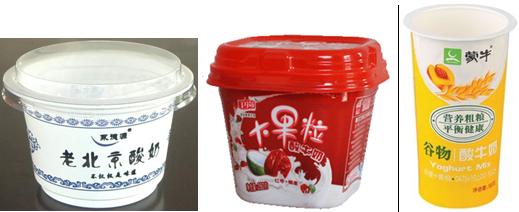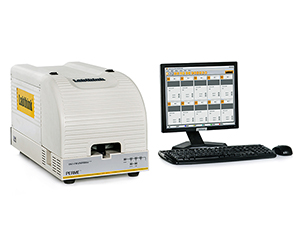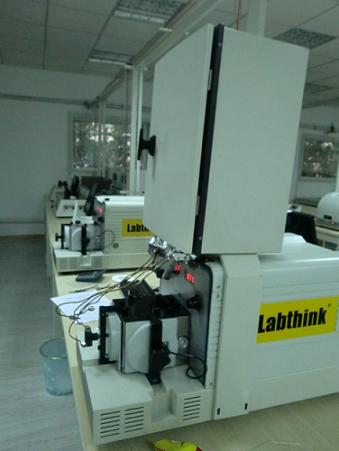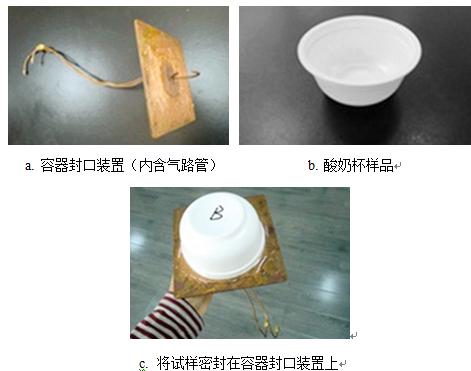Abstract: Yogurt is easy to carry and easy to digest and absorb. It is a common nutrient food in the public life. However, because it contains a lot of fats and proteins, it is easily oxidized by the oxygen components in the air and is therefore deteriorating. Therefore, in order to ensure that yoghurt products are not prone to quality problems during their shelf life, and to obtain a longer shelf life, the yoghurt cups used must have high oxygen barrier properties. The lower the oxygen permeability, the better the oxygen barrier performance. . This article mainly introduces the test method and principle of the oxygen barrier of the yogurt cup, details the technical information of the testing process, and provides a solid reference for related industries.
Keywords: yogurt, dairy products, yogurt cups, oxygen barrier, barrier properties, oxygen permeability, oxidative deterioration, container oxygen permeability tester, oxygen permeability test system, oxygen permeability tester
Test significance:
Yogurt is a kind of highly nutritious dairy product that has been added with special bacteria (ie, starter) to pasteurized fresh milk and then cooled and filled after fermentation. Yogurt contains many nutrients such as protein, fat, vitamins, and beneficial bacteria, and is easily digested and absorbed by the body. In view of processing needs and convenience for consumers, most yogurt products use cups, and most of the yogurt cups used are plastics. Their materials are mainly PP, PS, and PE, which are common white plastic cups, but also include PE/paper/PE composite paper-based yogurt cup. While filling the yoghurt, the yoghurt cup needs to be sterilized in different ways to ensure that the yoghurt is not easily degenerated by other harmful bacteria. In order to prevent the oxidative deterioration quality of yoghurt, the requirement of the oxygen barrier of the yoghurt cup is also high. If the oxygen barrier property is poor, the yoghurt is easily oxidized by the oxygen that penetrates from the outside to the inside, and the yoghurt moldy occurs. Cups and yoghurts are quality problems such as bean curd residue.
The thicker the thickness of the plastic yoghurt cup, or the higher the density of the material used, the higher the barrier property of the yoghurt cup, including the oxygen barrier property and moisture resistance. How to monitor the barrier of the yoghurt cup to the outside world, and whether the oxygen barrier of the yoghurt cup meets the quality requirement of the marked shelf life, it is necessary to rely on the detection of its oxygen transmission rate. The smaller the transmittance, the higher the oxygen resistance. The higher the sex. This article is based on professional oxygen permeability testing equipment used for testing containers. It introduces in detail the testing process and method principles of oxygen permeability of yogurt cups using PP as a material, and provides powerful information for the production and use of yogurt cups. Technical reference.

Figure 1 example of yogurt cup
Detection method:
The international oxygen transmission rate test method is divided into equal pressure method and differential pressure method, in which the equal pressure method uses a Coulomb power sensor to absorb oxygen through the film and convert it into a current signal, thereby calculating the oxygen transmission rate, and the detection limit thereof. Low, can accurately test the oxygen transmission rate of high barrier materials, and isobaric methods can overcome the unavoidable impact of differential pressure on the plastic containers due to the differential pressure, so that the oxygen permeability of test containers can be expanded. Therefore, at home and abroad, the oxygen transmission rate of container packaging materials is mostly measured by the equal pressure method (coulomb power sensor method), but in recent years, related instrument manufacturers have gradually solved the impact of differential pressure method on containers. A gas barrier has been developed to test low-barrier packaging containers (ie, high gas permeability).
The oxygen permeability test of isometric pressure test containers at home and abroad mainly follows the international standard of ASTM F 1307 “Oxygen Transmission Rate of Dry Solid Packages Tested by Power Consumption Sensorsâ€, and there is no relevant domestic standard. We will use the OX2/230 Oxygen Permeability Test System independently developed by Labthink and combined with the above standards to perform Oxygen Permeability tests on PP cup yogurt cup samples.
1, test equipment
OX2/230 oxygen meter (Labthink blue light), three-cavity independent, ultra-high precision, can test three same or different samples at the same time, on the basis of ensuring the independent test of the sample, the test efficiency is increased by 3 times. The temperature control range is 15°C ~ 55°C, and the humidity control range is 0%RH, 35%RH ~ 90%RH. The system can test the oxygen transmission rate of the container in the range of 0.0001 ~ 60 cm3/(pkg·d). The system can also test the oxygen transmission rate of the film. The test range is (0.01 ~ 6,500) cm3/m2 · 24h and can be Expand to (0.07 ~ 6,5000) cm3/m2·24h. The system can support up to 10 instruments in parallel and establish an efficient system for 30 samples simultaneously tested.
The instrument meets various national and international standards of ASTM F1307, ISO 15105-2, GB/T 19789, ASTM D3985, ASTM F2622, ASTM F1927, JIS K7126-2, YBB 00082003, and can meet different plastics and rubbers in different temperature and humidity environments. Oxygen permeability test of bottles, bags, cans, cans, boxes, barrels and other containers made of paper, paper-plastic composite, glass, metal, etc., such as yogurt cups, Coke bottles, peanut oil drums, Tetra Pak packaging, vacuum packaging bags, Metal three-piece cans, plastic cosmetic packaging, toothpaste hoses, jelly cups, etc. It can also test the oxygen barrier properties of various plastic films and sheets.

a. Appearance of the closed system

b. System Appearance with Container Tester
Figure 2 OX2/230 oxygen transmission rate test system
2. Preparation of sample
A sample of 3 intact yogurt cups was placed in a laboratory environment of 23° C. and 50% RH for 48 hours.
3. Test conditions
Venue: Jinan Languang Packaging Safety Testing Center Test Temperature and Humidity: 23°C, 50% RH
Test method: Isobaric method (coulometric sensor method)
4. Test procedure
4.1 Test principle
OX2/230 uses the isobaric test principle. The pre-treated sample is clamped between the test chambers. Oxygen or air flows on one side of the film, and high purity nitrogen flows on the other side of the film. The oxygen molecules diffuse through the membrane to the high purity nitrogen in the other side and are carried by the flowing nitrogen to the sensor. The oxygen concentration measured by the sensor is analyzed to calculate parameters such as oxygen permeability. For packaging containers, high-purity nitrogen flows in the container, and air or high-purity oxygen surrounds the outside of the container.
4.2 Sample mounting
The sample was sealed on the container sealing device with a transparent fast-adhesive. After the sealing was completed, it was clamped inside the container testing device. Then, the position above the tray of the container sealing device was tightly packed with a sealed bag. According to the above method, the other two samples were clamped.


d. Clamp the specimen into the instrument and seal
Figure 3 sample mounting process
4.3 Detection process
OX2/230 automated test, the test process is simple:
Add distilled water, open the system air supply, and adjust the air supply pressure as required. According to the test requirements, add appropriate amount of distilled water to achieve the required O2, N2 humidity. Turn on the power and run the software. Set test temperature, test parameters, start test. Test parameters include control parameters (test mode, number of test cycles, test time, number of REZERO cycles, etc.) and sample parameters (type, area, thickness, etc.). Humidity and carrier gas flow rate adjustments were made during the test. End of test, data processing. Turn off the air supply and power supply.The average oxygen transmission rate of the three yogurt cups tested in this experiment was 0.0571 cm3/(pkg·d).
to sum up:
When Labthink Blue Oxygen OX2/230 Oxygen Permeability Test System was used to test the oxygen permeability of plastic cups of yogurt cups, high-precision oxygen-barrier results were obtained, accurately reflecting the barrier properties of yogurt cups. The test equipment and test standards used in this test are also applicable to the oxygen permeability test of containers with certain barrier properties for other uses. Labthink has been committed to providing professional testing services and equipment for customers around the world. Over the years, it has provided tens of thousands of barrier testing services to customers around the world, providing customers with reliable data support. Learn more testing instruments concerning the information, you can visit Labthink website to view specific information or call us. Labthink expects to enhance the technical exchanges and cooperation with enterprises and institutions in the industry.
Copyright Notice: The article is copyrighted by Jinan Languang Electromechanical Technology Co., Ltd.
Valves are found in virtually every industrial process, including water and sewage processing, mining, power generation, processing of oil, gas and petroleum, food manufacturing, chemical and plastic manufacturing and many other fields.
People in developed nations use valves in their daily lives, including plumbing valves, such as taps for tap water, gas control valves on cookers, small valves fitted to washing machines and dishwashers, safety devices fitted to hot water systems, and poppet valves in car engines.
In nature there are valves, for example one-way valves in veins controlling the blood circulation, and heart valves controlling the flow of blood in the chambers of the heart and maintaining the correct pumping action.
Valves may be operated manually, either by a handle, lever, pedal or wheel. Valves may also be automatic, driven by changes in pressure, temperature, or flow. These changes may act upon a diaphragm or a piston which in turn activates the valve, examples of this type of valve found commonly are safety valves fitted to hot water systems or boilers.
More complex control systems using valves requiring automatic control based on an external input (i.e., regulating flow through a pipe to a changing set point) require an actuator. An actuator will stroke the valve depending on its input and set-up, allowing the valve to be positioned accurately, and allowing control over a variety of requirements.
Valves
Stop Valves, Ball Cock, Angle Valves, Gate Valves, Check Valves
ZHEJIANG KINGSIR VALVE CO., LTD. , http://www.kingsirvalve.com